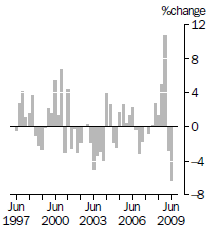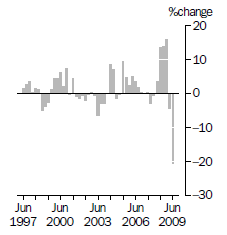JUNE KEY FIGURES
 | Mar Qtr 09 to Jun Qtr 09 | Jun Qtr 08 to Jun Qtr 09 |
 | % change | % change |
|
| Import Price Index all groups | -6.4 | 5.9 |
| Food and live animals | -3.2 | 13.5 |
| Beverages and tobacco | -1.5 | 9.1 |
| Crude materials, inedible, except fuels | -28.0 | -17.2 |
| Mineral fuels, lubricants and related materials | 6.1 | -40.0 |
| Animal and vegetable oils, fats and waxes | -14.3 | -0.3 |
| Chemicals and related products, n.e.c. | -6.6 | 9.1 |
| Manufactured goods classified chiefly by material | -9.5 | 14.1 |
| Machinery and transport equipment | -5.8 | 16.8 |
| Miscellaneous manufactured articles | -10.6 | 23.6 |
| Commodities and transactions, n.e.c. | -11.2 | 28.4 |
| Export Price Index all groups | -20.6 | -0.2 |
| Food and live animals | -9.8 | -3.2 |
| Beverages and tobacco | -5.1 | -1.1 |
| Crude materials, inedible, except fuels | -21.7 | -13.8 |
| Mineral fuels, lubricants and related materials | -34.4 | 17.9 |
| Chemicals and related products, n.e.c. | -5.3 | 6.2 |
| Manufactured goods classified chiefly by material | -6.3 | -31.0 |
| Machinery and transport equipment | -7.3 | 14.8 |
| Miscellaneous manufactured articles | -7.4 | 10.9 |
|
IMPORT PRICE INDEX: all groups, Quarterly % change

| EXPORT PRICE INDEX: all groups, Quarterly % change

|
JUNE KEY POINTS
IMPORT PRICE INDEX
- The Import Price Index decreased by 6.4% in the June quarter 2009, the largest quarterly decrease since the current series began in September quarter 1981. The decrease was driven mainly by the appreciation of the Australian dollar against all major trading currencies, as well as lower prices paid for miscellaneous manufactured articles, n.e.c. (-13.3%) and iron and steel (-22.8%). These falls were partly offset by rises in prices paid for petroleum, petroleum products and related materials (+6.1%). Through the year to June quarter 2009, the Import Price Index increased by 5.9%.
EXPORT PRICE INDEX
- The Export Price Index decreased by 20.6% in the June quarter 2009, the largest quarterly decrease since the current series began in September quarter 1974. The decrease was driven mainly by falls in prices received for coal, coke and briquettes (-36.8%) and metalliferous ores and metal scrap (-23.5%), as well as the appreciation of the Australian dollar against all major trading currencies. These falls were partly offset by rises in prices received for petroleum, petroleum products and related materials (+12.9%). Through the year to June quarter 2009, the Export Price Index decreased by 0.2%.
NOTES
FORTHCOMING ISSUES
| ISSUE (QUARTER) | Release Date |
| September 2009 | 23 October 2009 |
| December 2009 | 22 January 2010 |
| March 2010 | 23 April 2010 |
| June 2010 | 23 July 2010 |
FORTHCOMING CHANGES
As foreshadowed in the March quarter 2009 issue, the content and format of tables 14, 15, 17 and 19 (available on the ABS website) will change from September quarter 2009 to reflect the contemporary industrial classification (ANZSIC 2006). Further information can be found in the Appendix to the March quarter 2009 issue of this publication, as well as in
Information Paper: Update on ANZSIC 2006 Implementation for Producer and International Trade Price Indexes, Australia, 2009 (cat. no. 6427.0.55.002).
ROUNDING
Any discrepancies between totals and sums of components are due to rounding.
DATA REFERENCES
Data referenced in the Key points are available from the tables shown in this publication, or in the corresponding tables of this publication on the ABS website <
https://www.abs.gov.au>.
INQUIRIES
For further information about these and related statistics, contact the National Information and Referral Service on 1300 135 070 or Lee Taylor on Canberra (02) 6252 6251.
SUMMARY COMMENTARY
COMMENTARY
Links to Other Sections
To access the "Price Indexes and Contract Price Indexation" page use this link
Price Indexes and Contract Price Indexation
 Print Page
Print Page
 Print All
Print All